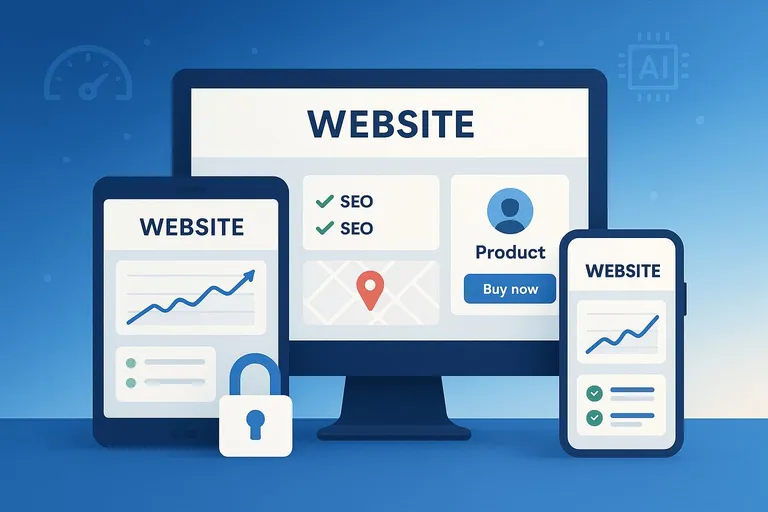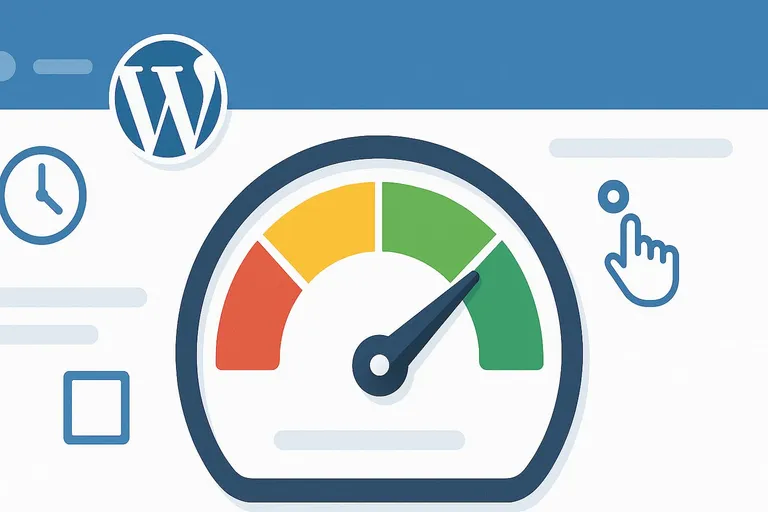Launching a website in 2025 isn’t just about going live—it’s about surviving in a digital landscape where 90% of new websites fail, primarily due to mobile optimization issues and technical oversights.
With 62.54% of web traffic now mobile and Google exclusively using mobile-first indexing since July 2024, the stakes have never been higher. Yet businesses that follow proven launch strategies achieve conversion rates 3x higher than those who skip critical steps.
This comprehensive checklist ensures your local business website not only launches successfully but thrives from day one. Skip any section at your own risk—the data shows that shortcuts lead to the 90% failure rate.
Why Website Launches Fail (And How to Avoid It)
The statistics are sobering but not surprising. Mobile optimization problems top the failure list, followed by performance issues where 4-second delays lead to 11% losses in page views. Infrastructure problems compound the issues, with 52% of data center outages caused by power failures.
The financial impact is immediate: small businesses lose $137-$427 per minute during downtime, while 88% of consumers won’t return after experiencing downtime. But here’s the opportunity—these failures are entirely preventable with proper planning.
Critical success factors for 2025:
- Mobile-first design and testing
- Core Web Vitals optimization (new standards as of March 2024)
- Accessibility compliance before legal deadlines
- Strategic launch timing and promotion
- Comprehensive testing across devices and browsers
Learn how our web design process prevents common launch failures
Pre-Launch Checklist: Foundation for Success
Domain and Hosting Setup
Your foundation determines everything that follows. Choose a domain that’s memorable and SEO-friendly, ideally reflecting your business name or primary service.
Hosting requirements for 2025:
- SSL certificates mandatory (87.8% of websites now use HTTPS)
- TLS 1.3 implementation for security and speed
- CDN integration for global performance
- 99.9% uptime guarantee with SLA backing
- Automatic backups and disaster recovery
Pro tip: Let’s Encrypt provides free SSL certificates that work perfectly for most local businesses, holding 59.8% market share for good reason.
Mobile-First Optimization (Non-Negotiable)
With mobile commerce representing 75% of all e-commerce sales by 2025, mobile optimization isn’t optional—it’s survival.
Mobile checklist essentials:
- Responsive design that adapts to all screen sizes
- Touch-friendly buttons (minimum 44x44 pixels)
- Readable text without zooming (16px minimum)
- Fast mobile loading (under 2 seconds target)
- Simplified navigation for thumb-friendly browsing
Use Google’s Mobile-Friendly Test and test on real devices. Remember: mobile users are 67% more likely to convert when they find optimized local business websites.
Core Web Vitals Optimization (Updated 2025 Standards)
Google updated Core Web Vitals in March 2024, introducing stricter standards that caused 600,000 websites to fail immediately. The new requirements focus on mobile-first performance with heightened emphasis on user interactions.
2025 Core Web Vitals thresholds:
- Largest Contentful Paint (LCP): Under 2.5 seconds
- Interaction to Next Paint (INP): Under 200 milliseconds (replaced FID)
- Cumulative Layout Shift (CLS): Under 0.1
Critical requirement: 75% of page views must meet “Good” thresholds for ALL three metrics simultaneously. Currently, only 23% of top mobile sites pass the 200ms INP threshold, creating a massive competitive opportunity.
Quick optimization wins:
- Compress images to WebP format
- Implement lazy loading for images
- Minimize JavaScript execution time
- Use efficient caching strategies
- Optimize server response times
Discover our Core Web Vitals optimization service
Content and SEO Preparation
Local SEO has evolved significantly, with Google Business Profile signals now accounting for 33% of all local ranking factors.
Local SEO checklist:
- Complete local keyword research for your geographic area
- Optimize meta tags and descriptions with local focus
- Create location-specific content that serves your community
- Implement schema markup (LocalBusiness type with specific subtypes)
- Set up Google Business Profile with all predefined services selected
Remember: 80% of US consumers search online for local businesses weekly, with 76% of “near me” searchers visiting a business within 24 hours.
Legal and Accessibility Compliance
Website accessibility shifted from best practice to legal requirement in 2025. 8,800+ ADA Title III lawsuits were filed in 2024—a 7% increase from 2023.
Immediate compliance requirements:
- WCAG 2.2 Level AA compliance (86 success criteria)
- European Accessibility Act compliance by June 28, 2025 (affects any EU customers)
- Color contrast ratios meeting accessibility standards
- Alt text for all images and multimedia
- Keyboard navigation support throughout the site
- Form labels and error messages clearly identified
Avoid accessibility overlay widgets—they increase lawsuit risk rather than reducing it.
Take Control of Your Launch Process
Ready to ensure every critical detail is covered? Our interactive website launch checklist tool transforms this comprehensive guide into a trackable, actionable plan.
✅ Track your progress in real-time
✅ Add custom tasks specific to your business
✅ Never miss a critical step again
✅ Export your personalized checklist as PDF
Start Your Interactive Launch Checklist →
For a successful local business launch
Launch Day Checklist: Going Live Successfully
Final Technical Verification
Launch day isn’t the time to discover problems. Your final checks should include:
Pre-launch technical audit:
- Broken link scan across all pages
- Form testing with real submissions
- 404 error prevention with proper redirects
- Cross-browser compatibility (Chrome, Safari, Firefox, Edge)
- Load testing under traffic simulation
- Analytics and tracking verification
Backup preparation:
- Complete site backup before DNS changes
- Database backup for dynamic content
- DNS propagation plan and timeline
- Rollback procedure if issues arise
Strategic Launch Timing
Data shows Tuesday at 10 AM local time provides maximum visibility, avoiding Monday preparation and Friday weekend transitions. Never launch on weekends or before major holidays when support resources are limited.
Seasonal considerations:
- Q1 (January-March): Ideal for “New Year, New Business” messaging
- September-October: Perfect for B2B launches (post-summer, pre-holidays)
- Industry-specific timing: Avoid peak competition periods
Launch Day Promotion Strategy
Your launch day should coordinate multiple channels for maximum impact:
Multi-channel launch tactics:
- Email marketing to your entire list
- Social media blitz across all platforms
- Google Business Profile post with special offer
- Press release to local media outlets
- Personal outreach to key contacts and partners
First 24-hour monitoring:
- Real-time analytics tracking
- Error monitoring and immediate fixes
- User feedback collection and response
- Search console error identification
- Performance metric verification
Post-Launch Optimization: Sustaining Success
Critical First Week Actions
The first week determines long-term success. Daily monitoring during this period is non-negotiable.
Week 1 priorities:
- Analytics verification: Ensure all tracking works correctly
- Search Console monitoring: Submit sitemap and fix crawl errors
- Performance testing: Verify Core Web Vitals under real traffic
- User feedback collection: Identify immediate UX issues
- Content updates: Fix any typos or formatting issues discovered
Building Long-Term Momentum
Launch success extends far beyond going live. Plan for sustained growth:
30-day post-launch strategy:
- Daily performance monitoring with weekly optimization sprints
- Content marketing campaign to drive initial traffic
- Local networking and promotion in your community
- Review and testimonial collection to build credibility
- SEO refinement based on Search Console data
90-day optimization goals:
- Conversion rate optimization through A/B testing
- Local citation building for improved search visibility
- Content expansion based on user behavior data
- Performance fine-tuning to exceed Core Web Vitals thresholds
Measuring Launch Success: Key Metrics to Track
Success isn’t just about going live—it’s about achieving business goals. Track these metrics to ensure your launch delivers results:
Critical performance indicators:
- Conversion rates: Target 3x improvement over industry averages
- Mobile traffic engagement: Should represent 60%+ of total traffic
- Core Web Vitals scores: All three metrics in “Good” range
- Local search visibility: Track ranking improvements for target keywords
- User experience metrics: Bounce rate, session duration, pages per visit
Financial impact measurements:
- Cost per acquisition compared to other marketing channels
- Revenue per visitor improvements over time
- Customer lifetime value from website-generated leads
- Return on investment within 6-12 months
Schedule a post-launch optimization consultation to maximize your website’s performance.
Common Launch Mistakes to Avoid
Learning from others’ failures saves time and money:
Top launch mistakes:
- Launching without mobile testing on real devices
- Skipping accessibility compliance (legal risk)
- Inadequate performance optimization (conversion killer)
- Poor launch timing (reduced visibility)
- Insufficient pre-launch marketing (missed momentum)
- No backup plan when issues arise
- Forgetting post-launch optimization (stagnant results)
Your Website Launch Action Plan
Ready to join the 10% of websites that succeed? Here’s your immediate action plan:
Phase 1 (Weeks 1-2): Foundation
- Secure reliable hosting with SSL
- Begin mobile-first design and development
- Start pre-launch marketing list building
- Plan content and SEO strategy
Phase 2 (Weeks 3-4): Development
- Implement responsive design
- Optimize for Core Web Vitals
- Ensure accessibility compliance
- Set up analytics and tracking
Phase 3 (Weeks 5-6): Testing
- Comprehensive cross-device testing
- Performance optimization
- Content review and SEO refinement
- Soft launch to limited audience
Phase 4 (Week 7): Launch
- Final technical verification
- Coordinated promotional campaign
- Intensive monitoring and support
- Immediate issue resolution
Phase 5 (Weeks 8-12): Optimization
- Performance analysis and improvements
- User feedback implementation
- SEO refinement and content expansion
- Conversion rate optimization
The Bottom Line
In 2025’s competitive digital landscape, website launches are make-or-break moments for local businesses. With 90% of new websites failing and mobile optimization requirements stricter than ever, there’s no room for shortcuts.
But the data also reveals unprecedented opportunity: businesses following comprehensive launch strategies achieve 3x higher conversion rates, while mobile-optimized sites see 67% higher conversion rates than non-optimized alternatives.
Your website launch isn’t just about going live—it’s about positioning your business for sustained digital success. Follow this checklist, avoid the common pitfalls, and join the 10% of websites that not only survive but thrive.
Ready to launch with confidence? Don’t leave success to chance.
Start your strategic website launch consultation with our San Diego team today.
Need immediate help with technical requirements? Use our free website audit tool to identify critical issues before launch.
FAQs
What's the biggest cause of website launch failures in 2025?
Mobile optimization issues are the leading cause, contributing to the 90% website failure rate. With 62.54% of traffic now mobile and Google's mobile-first indexing, poor mobile experience makes sites essentially invisible to search engines.
How long should I plan for a website launch?
Plan 2-3 months total: 4-6 weeks for development, 2-3 weeks for pre-launch testing and optimization, and 2-4 weeks for pre-launch marketing. Launch day itself requires 1-2 days of intensive monitoring.
What are Core Web Vitals and why do they matter for my launch?
Core Web Vitals are Google's speed and user experience metrics: Largest Contentful Paint (under 2.5s), Interaction to Next Paint (under 200ms), and Cumulative Layout Shift (under 0.1). Poor scores directly hurt rankings and conversions.
Do I need accessibility compliance for my small local business?
Yes. 77% of ADA lawsuits target businesses under $25M revenue. The European Accessibility Act (June 2025) affects any business serving EU customers, with penalties up to €3 million plus potential suspension.
When is the best time to launch my website?
Tuesday at 10 AM local time provides maximum visibility. Avoid weekends, Mondays, Fridays, and major holidays. Q1 (January-March) and September-October are optimal seasons for most businesses.
What's the difference between a soft launch and public launch?
A soft launch involves releasing to a limited audience (family, friends, select customers) for testing and feedback. Public launch is the full announcement with marketing campaigns. Always soft launch first.
How much should I budget for website launch marketing?
Plan 10-20% of your total website budget for launch marketing. This covers email campaigns, social media advertising, PR outreach, and promotional materials for the first 30 days post-launch.
What should I monitor immediately after launching?
Monitor 404 errors, page load speeds, form submissions, analytics tracking, search console errors, and user feedback. The first 48 hours are critical for identifying and fixing immediate issues.



